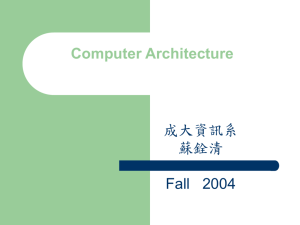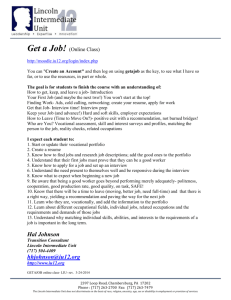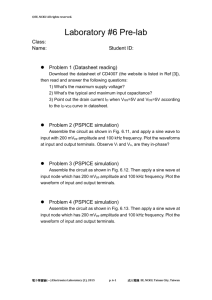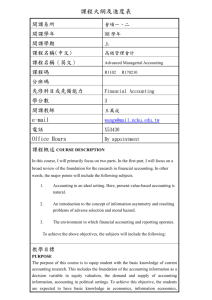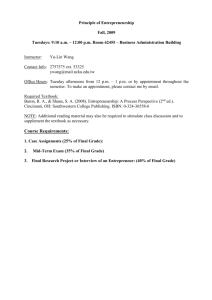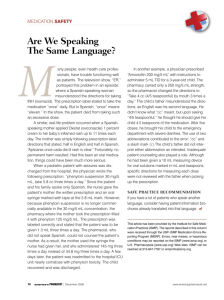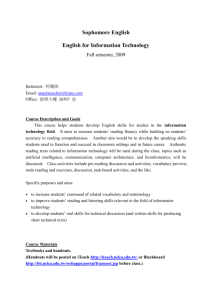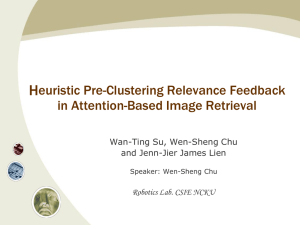H.225 Call Signaling
advertisement
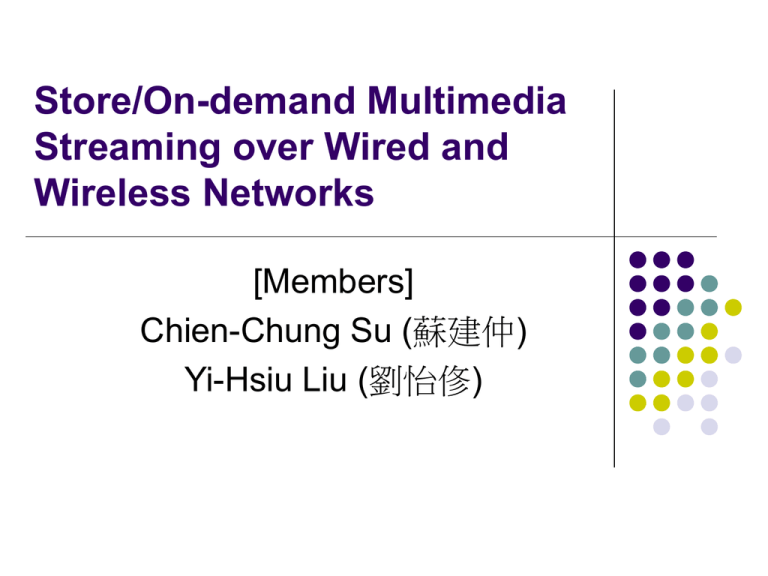
Store/On-demand Multimedia Streaming over Wired and Wireless Networks [Members] Chien-Chung Su (蘇建仲) Yi-Hsiu Liu (劉怡俢) Outline Definition Characteristics/Requirements Basic technologies References Conclusion ISMP Lab, CSIE, NCKU 2 Definition (1/3) Streaming Real-time Multi-user Streaming protocol RTP, RTSP ITU-T H.323 MMS streaming protocol ISMP Lab, CSIE, NCKU 3 Live shows Definition (2/3) Live streaming MOD system Subscriber On-demand streaming ISMP Lab, CSIE, NCKU 4 Definition (3/3) MoD (Multimedia-on-Demand) allows users to select the multimedia they like in their favorite way. Any time Any where Any contents Application Entertainment Education … ISMP Lab, CSIE, NCKU 5 Agenda Definition Characteristics/Requirements Basic Technologies References Conclusion ISMP Lab, CSIE, NCKU 6 Characteristic/Requirement Characteristic Multimedia stored server Distributed environment VCR facilities Multimedia indexing Requirement Quality of Service Multimedia on wireless network and 3G network Multimedia information retrieval ISMP Lab, CSIE, NCKU 7 Agenda Definition Characteristics/Requirements Basic Technologies References Conclusion ISMP Lab, CSIE, NCKU 8 Introduction to H.323 ITU-T Recommendation H.323 by Liuyh ISMP Lab, CSIE, NCKU 9 Topics Covered What Is H.323? H.323 Components H.323 Zone Protocols Specified by H.323 Terminal Characteristics Gateway Characteristics Gatekeeper Characteristics H.225 Registration, Admission, and Status H.225 Call Signaling H.245 Control Signaling Connection Procedures Interworking with Other Multimedia Networks ISMP Lab, CSIE, NCKU 10 What Is H.323? The H.323 standard is a cornerstone technology for the transmission of real-time audio, video, and data communications over packet-based networks It specifies the components, protocols, and procedures providing multimedia communication over packet-based networks H.323 can be applied in a variety of mechanisms audio only (IP telephony); audio and video … H.323 provides myriad services and, therefore, can be applied in a wide variety of areas consumer, business, and entertainment applications. ISMP Lab, CSIE, NCKU 11 H.323 in Relation to Other Standards of the H.32x Family The other recommendations of the family specify multimedia communication services over different networks: H.324 over SCN H.320 over integrated services digital networks (ISDN) H.321 and H.310 over broadband integrated services digital networks (B-ISDN) H.322 over LANs that provide guaranteed QoS One of the primary goals in the development of the H.323 standard was interoperability with other multimedia-services networks This interoperability is achieved through the use of a gateway ISMP Lab, CSIE, NCKU 12 H.323 Components The H.323 standard specifies four kinds of components provide the point-to-point and point-tomultipoint multimedia-communication services: terminals gateways gatekeepers multipoint control units (MCUs) ISMP Lab, CSIE, NCKU 13 Terminals Used for real-time bidirectional multimedia communications , running an H.323 and the multimedia applications Because the basic service provided by an H.323 terminal is audio communications, an H.323 terminal plays a key role in IP-telephony services The primary goal of H.323 is to inter-work with other multimedia terminals. H.323 terminals are compatible with H.324 terminals on SCN … ISMP Lab, CSIE, NCKU 14 Gateways A gateway connects two dissimilar networks. An H.323 gateway provides connectivity between an H.323 network and a non-H.323 network This connectivity of dissimilar networks is achieved by translating protocols for call setup and release, converting media formats between different networks, and transferring information between the networks connected by the gateway A gateway is not required, however, for communication between two terminals on an H.323 network. ISMP Lab, CSIE, NCKU 15 Gatekeepers A gatekeeper can be considered the brain of the H.323 network. It is the focal point for all calls within the H.323 network Although they are not required, gatekeepers provide important services such as : addressing authorization authentication of terminals and gateways bandwidth management call-routing services … ISMP Lab, CSIE, NCKU 16 Multipoint Control Units MCUs provide support for conferences of three or more H.323 terminals. All terminals participating in the conference establish a connection with the MCU. The MCU manages conference resources, negotiates between terminals for the purpose of determining the audio or video coder/decoder (CODEC) to use The gatekeepers, gateways, and MCUs are logically separate components of the H.323 standard but can be implemented as a single physical device. ISMP Lab, CSIE, NCKU 17 H.323 Zone An H.323 zone is a collection of all terminals, gateways, and MCUs managed by a single gatekeeper (see Figure 2). A zone includes at least one terminal and may include gateways or MCUs. A zone has only one gatekeeper. A zone may be independent of network topology and may be comprised of multiple network segments that are connected using routers or other devices ISMP Lab, CSIE, NCKU 18 Protocols Specified by H.323 The protocols specified by H.323 are listed below. H.323 is independent of the packet network and the transport protocols over which it runs and does not specify them. audio CODECs video CODECs H.225 registration, admission, and status (RAS) H.225 call signaling H.245 control signaling real-time transfer protocol (RTP) real-time control protocol (RTCP) ISMP Lab, CSIE, NCKU 19 ISMP Lab, CSIE, NCKU 20 Audio CODEC An audio CODEC encodes the audio signal from the microphone for transmission on the transmitting H.323 terminal and decodes the received audio code that is sent to the speaker on the receiving H.323 terminal. Because audio is the minimum service provided by the H.323 standard, all H.323 terminals must have at least moe audio CODEC support ISMP Lab, CSIE, NCKU 21 Video CODEC A video CODEC encodes video from the camera for transmission on the transmitting H.323 terminal and decodes the received video code tat is sent to the video display on the receiving H.323 terminal. Because H.323 specifies support of video as optional, the support of video CODECs is optional as well ISMP Lab, CSIE, NCKU 22 H.225 Registration, Admission, and Status Registration, admission, and status(RAS) is the protocol between endpoints and gatekeepers. The RAS is used to perform registration, admission control, bandwidth change, status , and disengage procedures between endpoints and gatekeepers. A RAS channel is used to exchange RAS messages. This signaling channel is opened between an endpoint and a gatekeeper prior to the establishment of any other channels ISMP Lab, CSIE, NCKU 23 H.225 Call Signaling The H.225 call signaling is used to establish a connection between two H.323 endpoints. This is achieved by exchanging H.225 protocol messages on the call-signaling channel. The call-signaling channel is opened between two H.323 endpoints or between an endpoint and the gatekeeper. ISMP Lab, CSIE, NCKU 24 H.245 Control Signaling H.245 control signaling is used to exchange end-toend control messages governing the operation of the H.323 endpoint. These control messages carry information related to the following: Capabilities exchange Opening and closing of logical channels used to carry media streams Flow-control messages General commands and indications ISMP Lab, CSIE, NCKU 25 Real-Time Transport Protocol usage: RTP provides end-to-end network transport functions suitable for applications transmitting real-time data disadvantage: RTP does not guarantee quality-of-service for real-time services. The data transport is augmented by a control protocol (RTCP) to allow monitoring of the data delivery in a manner scalable to large multicast networks, and to provide minimal control and identification functionality. conclusion: RTP and RTCP are designed to be independent of the underlying transport and network layers. The protocol supports the use of RTP-level translators and mixers. ISMP Lab, CSIE, NCKU 26 Terminal Characteristics H.323 terminals must support the following: H.245 for exchanging terminal capabilities and creation of media channels H.225 for call signaling and call setup RAS for registration and other admission control with a gatekeeper RTP/RTCP for sequencing audio and video packets H.323 terminals must also support the G.711 audio CODEC. Optional components in an H.323 terminal are video CODECs, T.120 data-conferencing protocols, and MCU capabilities ISMP Lab, CSIE, NCKU 27 Gateway Characteristics A gateway provides translation of protocols for call setup and release, conversion of media formats between different networks, and the transfer of information between H.323 and non-H.323 networks An application of the H.323 gateway is in IP telephony, where the H.323 gateway connects an IP network and SCN network ISMP Lab, CSIE, NCKU 28 Gateway Characteristics (cont) On the H.323 side, a gateway runs H.245 control signaling for exchanging capabilities…On the SCN side, a gateway runs SCNspecific protocols (e.g., ISDN and SS7 protocols) Terminals communicate with gateways using the H.245 controlsignaling protocol and H.225. The gateway translates these protocols in a transparent fashion to the respective counterparts on the nonH.323 network and vice versa Audio and video translation may not be required Gatekeepers are aware of which endpoints are gateways because this is indicated when the terminals and gateways register with the gatekeeper A gateway may be able to support several simultaneous calls between the H.323 and non-H.323 networks ISMP Lab, CSIE, NCKU 29 Gatekeeper Characteristics Gatekeepers provide call-control services for H.323 endpoints, such as address translation and bandwidth management as defined within RAS. Gatekeepers in H.323 networks are optional. If they are present in a network, however, terminals and gateways must use their services. The H.323 standards both define mandatory services that the gatekeeper must provide and specify other optional functionality that it can provide. Mandatory Gatekeeper Functions Address Translation Admission Control Bandwidth Control Zone Management Optional Gatekeeper Functions Call-Control Signaling Call Authorization Call Management ISMP Lab, CSIE, NCKU 30 H.225 Registration, Admission, and Status The H.225 RAS is used between H.323 endpoints (terminals and gateways) and gatekeepers for the following: gatekeeper discovery (GRQ) endpoint registration endpoint location admission control The RAS messages are carried on a RAS channel that is unreliable. Hence, RAS message exchange may be associated with timeouts and retry counts. ISMP Lab, CSIE, NCKU 31 H.225 Call Signaling H.225 call signaling is used to set up connections between H.323 endpoints (terminals and gateways), over which the real-time data can be transported. Call signaling involves the exchange of H.225 protocol messages over a reliable call-signaling channel. H.225 messages are exchanged between the endpoints if there is no gatekeeper in the H.323 network. When a gatekeeper exists in the network, the H.225 messages are exchanged either directly between the endpoints or between the endpoints after being routed through the gatekeeper. The method chosen is decided by the gatekeeper during RAS admission message exchange. Gatekeeper-Routed Call Signaling Direct Call Signaling ISMP Lab, CSIE, NCKU 32 H.245 Control Signaling H.245 control signaling consists of the exchange of endto-end H.245 messages between communicating H.323 endpoints The H.245 control channel is the logical channel 0 and is permanently open, unlike the media channels, a logical channel is unidirectional The messages carried include messages to exchange capabilities of terminals and to open and close logical channels. Capabilities Exchange Logical Channel Signaling ISMP Lab, CSIE, NCKU 33 Connection Procedures This module describes the steps involved in creating an H.323 call, establishing media communication, and releasing the call. ISMP Lab, CSIE, NCKU 34 ISMP Lab, CSIE, NCKU 35 ISMP Lab, CSIE, NCKU 36 Interworking with Other Multimedia Networks The H.323 protocol is specified so that it interoperates with other networks. The most popular H.323 interworking is IP telephony, when the underlying network of H.323 is an IP network and the interoperating network is SCN (see Figure 10). ISMP Lab, CSIE, NCKU 37 Interworking with Other Multimedia Networks (cont) H.323 is compatible with various other H.32x networks. Figure 11 shows an H.323 zone interworking with all H.32x networks. ISMP Lab, CSIE, NCKU 38 Agenda Definition Characteristics/Requirements Basic Technologies References Conclusion ISMP Lab, CSIE, NCKU 39 References Multimedia Server VCR Facilities Multicast Wireless Quality of Services Others ISMP Lab, CSIE, NCKU 40 Multimedia Server Characteristics Real-time storage Large storage space and data transfer rate How to improve the performance Disk scheduling algorithm Reading and buffering requirement Admission control ISMP Lab, CSIE, NCKU 41 VCR Facilities Bandwidth management Hold Bandwidth Delay Scheme Release Bandwidth Delay Scheme Stop display when waiting for VCR bandwidth Low waiting time Loss Scheme Continue display when waiting for VCR bandwidth Reducing quality for smooth VCR-like function Synchronization ISMP Lab, CSIE, NCKU 42 Multicast (1) Heterogeneous network (Internet) Multi-rate transmission 1 Kbs in some cellular networks Terabytes per second in optical networks Transmit streams at multiple data rates with dedicated multicast groups Layered multicast Orthogonal layered multicast The sum of the rates of all its layers dose not exceed the rate of the highest resolution signal ISMP Lab, CSIE, NCKU 43 Multicast (2) Problem Bandwidth is wasted in heterogeneous network with conventional multicast ISMP Lab, CSIE, NCKU 44 Multicast (3) Solution Orthogonal layered multicast ISMP Lab, CSIE, NCKU 45 Wireless (1) QoS problem is far more challenging in wireless networks Host mobility Scarcity of bandwidth Channel fading ISMP Lab, CSIE, NCKU 46 Wireless (2) QoS parameters Traditional QoS parameters Bandwidth End-to-end delay Jitter Wireless QoS parameters Call Blocking Probability (CBP) Call Dropping Probability (CDP) The probability of a new connection will be denied The probability of a existing connection will be forcibly terminated during a hand-off Bandwidth utilization ISMP Lab, CSIE, NCKU 47 Wireless (3) Three mechanism for handling handoff Queuing of hand-off reques Channel rearrangement Channel reservation Fixed reservation Statistical reservation New technique for handling handoff Rate-based borrowing scheme ISMP Lab, CSIE, NCKU 48 Wireless (4) Rate-based borrowing scheme M : desired bandwidth M : minimum bandwidth Bandwidth Loss tolerance (BLT) Actual Borrowable Bandwidth (ABB) ISMP Lab, CSIE, NCKU 49 Quality of Services (1) There are many techniques could applied on QoS management Three main QoS mechanism resource reservation(integrated service) priority mechanisms(differentiated service) application control ISMP Lab, CSIE, NCKU 50 Quality of Services (2) Integrated service ISMP Lab, CSIE, NCKU 51 Quality of Services (3) Differentiated service Q1 Classifier Q2 Packets in Scheduler . . . Packets out Qk Queuing system ISMP Lab, CSIE, NCKU 52 Quality of Services (4) 機制 描述 優點 缺點 resource reservation 在建立連線之前,須向所有路徑上的路由器 要求適當的資源 較好的服務品質保證 1. 2. priority mechanisms router會根據封包的優先權給予適當的處理 不會過度浪費網路頻 寬 1. 2. application control 利用congenstion control和transmission-rate adaptation來達到QoS的目的 不需要去大幅更動現 有的網路架構 ISMP Lab, CSIE, NCKU 路徑上的路由器都必須 支援此方法並且具有足 夠的資源 網路頻寬可能被浪費掉 路徑上的所有路由器要 支援此方法 如何訂立好的優先權的 順序是目前許多QoS的 機制仍在探討的問題 如何設計出有效的 congenstion control或 flow conrol機制是主要 的挑戰 53 Others Proxy server Compression Error detection and correction Synchronization Multimedia information retrieval ISMP Lab, CSIE, NCKU 54 Agenda Definition Characteristics/Requirements Basic Technologies References Conclusion ISMP Lab, CSIE, NCKU 55 Future works Multimedia network will be one part of humans’ life. Key points of multimedia development Wireless network support multimedia Multimedia retrieval Quality of Services ISMP Lab, CSIE, NCKU 56
